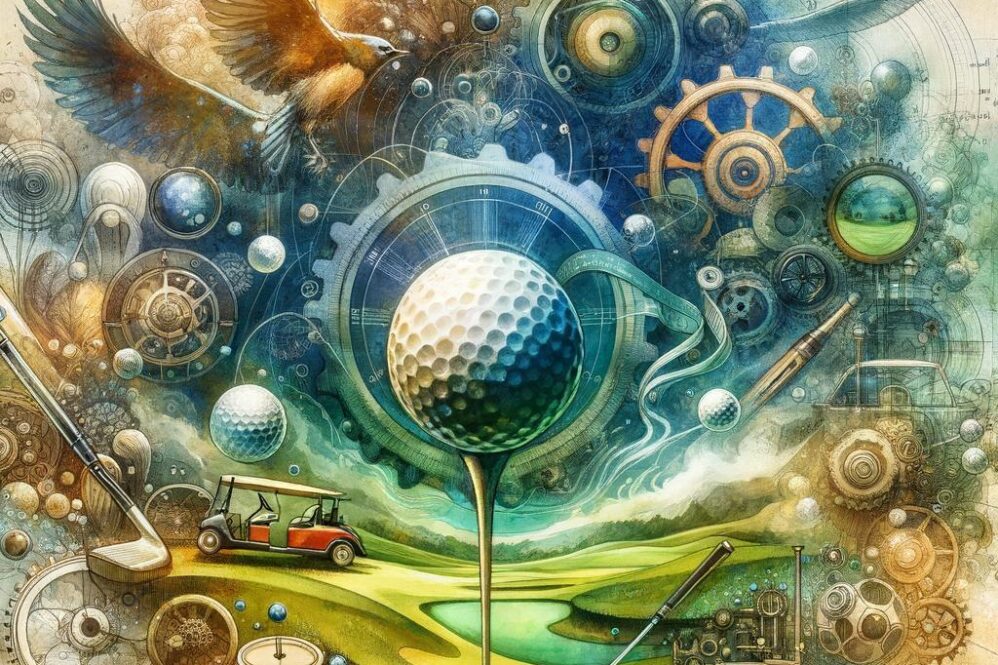The journey of golf reflects its deep-rooted heritage and the evolving societal dynamics that have influenced its advancement over the centuries. Originating in the 15th century on the rugged links of Scotland, this sport has crossed geographical boundaries to become a worldwide sensation. By closely examining its historical progression, we can uncover how the formulation of rules, course designs, and cultural influences have worked together to maintain the sport’s traditional essence while also embracing modernization. This article aims to unravel the intricate history of golf, emphasizing significant milestones and transformative events that have not only shaped the game but also impacted broader social contexts. In doing so, it seeks to provide a richer understanding of golf’s lasting appeal and significance in contemporary society.
The Birth of Golf: From Early Games to Contemporary Sport
The roots of golf can be traced back to medieval games played in Scotland during the 15th century, where early iterations of the sport involved striking a ball towards a target using basic clubs. Unlike the meticulously maintained courses of today, these initial games unfolded on uneven terrains, incorporating natural features that influenced gameplay. The first recorded mention of golf dates back to 1457 when King James II of Scotland prohibited the game, perceiving it as a distraction from military training. Still, the sport continued to flourish, evolving from a pastime of the elite to one enjoyed by the general populace.
By the 16th century, more organized forms of golf began to emerge, particularly in Edinburgh, where the establishment of the **Old Course at St Andrews** laid the groundwork for standardizing the game’s rules. This landmark location not only became the first official site for the sport but also the birthplace of essential golfing traditions. During this era, the first known set of rules was created, addressing aspects such as the number of strokes permitted and the treatment of the course itself. These regulations formed the basis for future governance and organization of the game, transforming it from a chaotic pastime into a more structured sport.
The **18-hole format**, now a hallmark of the golfing experience, solidified itself in the late 19th century, marking a crucial turning point in golf’s evolution. Initially, courses varied widely in design and the number of holes; however, the adoption of the standardized 18-hole layout at **St Andrews** in 1764 provided a model that established a universally accepted structure for golf courses globally. Notably, the establishment of the Royal and Ancient Golf Club of St Andrews, formed in 1754, became a pivotal institution in standardizing the rules of play and serving as a governing body for the sport. These clubs played a vital role in organizing competitions, promoting etiquette, and enhancing the sport’s reputation, solidifying golf’s status as both a sport and a leisure activity.
The Adoption of the 18-Hole Format: Standardization and Its Implications
The shift to the 18-hole format in golf signifies a pivotal moment in the sport’s history, highlighting a period of standardization that propelled its global appeal. Before this change, courses varied considerably in size and layout, typically ranging from 5 to 25 holes. This inconsistency not only caused confusion among players but also hindered the development of competitive play. The formal adoption of the 18-hole standard was primarily advocated by the St Andrews Links in the 18th century, where it was codified through the establishment of the Royal and Ancient Golf Club in 1754. This standardization initiated a movement that connected golfers across different regions, fostering a sense of community and shared experience.
One notable impact of the 18-hole format was its effect on the game’s pacing and strategy. As courses adopted this standardized layout, players began to develop a more sophisticated understanding of course management. Rather than focusing solely on power and precision, strategies began to incorporate elements like shot placement, club selection, and comprehension of the green’s contours. The requirement to complete a longer course in fewer strokes encouraged the development of more nuanced skills. This shift not only elevated the standard of play but also enriched the spectator experience, as audiences could engage with the tactical aspects of the game in ways that were previously absent.
Furthermore, the widespread acceptance of the 18-hole format facilitated the establishment of various golf associations and tournaments, which further legitimized the sport. National and international events, such as The Open Championship, gained prominence as they adhered to this standardized course layout, attracting talented players from around the globe. Consequently, golf transitioned from a local pastime into a celebrated global sport, appealing to a diverse range of participants. The standardization of the 18-hole format has become a cornerstone of golf’s identity, essential for fostering both competition and camaraderie within the storied tradition of the game.
| Year | Event | Significance |
|---|---|---|
| 1754 | Establishment of the Royal and Ancient Golf Club | Codification of rules and promotion of the 18-hole format |
| 1860 | Inaugural Open Championship | Introduction of competitive play using the 18-hole standard |
| 1921 | Formation of the PGA | Standardization in professional golf, further enhancing the 18-hole format’s status |
The Codification of Golf Rules: Influences and Historical Contexts
The formalization of golf rules emerged as a crucial milestone in the sport’s narrative, marking the transition from informal play to a more structured competitive environment. Early iterations of the game did not adhere to any standardized regulations, resulting in varied interpretations of rules among regional players. This lack of uniformity highlighted the necessity for a formal code, leading to the formation of the **Society of St. Andrews Golfers** in 1754, one of the first governing bodies dedicated to establishing an accepted framework for the game. The introduction of the 13 original rules laid the foundation for modern play, reflecting societal behaviors and the ethos of sportsmanship that surrounded early golf.
As golf gained traction in various parts of the world, particularly in Britain and the British Empire, the need for unity in gameplay became apparent. Influential golf clubs and organizations, driven by growing interest, increasingly contributed to refining these foundational rules. In 1864, the **Royal and Ancient Golf Club of St Andrews** took on the responsibility of overseeing rule consolidation, further formalizing regulations. The establishment of the **Rules of Golf** provided essential directives on gameplay, equipment, and course etiquette, reinforcing a culture of respect and fair play. This evolution enhanced the sport’s appeal by making golf more accessible and understandable to a broader demographic, paving the way for its global proliferation.
The integration of technology and innovation into the golfing realm has also played a significant role in shaping the rules and etiquette associated with the sport. In the late 19th and early 20th centuries, advancements in club and ball technology prompted discussions among governing bodies about the implications of these changes on gameplay and fairness. Debates surrounding the impact of new materials, such as gutta-percha for balls and steel for clubs, necessitated ongoing adjustments to the regulations. This dynamic interplay between technology and rules culminated in periodic updates and amendments to the established code, ensuring that the spirit and integrity of golf remained intact while accommodating the evolving nature of the sport.
Technological Advancements in Golf: Enhancing Play and Experience
The incorporation of technology into golf has fundamentally transformed both the mechanics of play and the overall experience for players and spectators alike. The late 20th century witnessed the introduction of computer-aided design (CAD) in equipment manufacturing, allowing for greater precision in club and ball design. Consequently, modern golf clubs feature materials and structures that optimize performance. Some key advancements include:
- Launch Monitors: Devices that analyze swing speed, launch angle, and spin rate, providing players with data to refine their mechanics.
- Swing Analysis Software: Programs that utilize video and data analytics to offer detailed feedback on swing technique.
- Smart Golf Balls: Equipped with sensors to track performance metrics, enhancing practice sessions with data insights.
Moreover, the development of GPS technology has revolutionized course management, enabling golfers to access precise distances and course layouts at their fingertips. Mobile applications integrate this technology with social features, enhancing player engagement. The emergence of virtual reality (VR) has also provided immersive practice environments that simulate various course conditions, allowing players to refine their skills even when not on the course. This technological convergence fosters a community around the sport, as players can share their progress and insights. Advancements in these areas contribute significantly to a more informed and engaged golfing populace.
As golf continues to embrace innovation, it is indeed essential to consider the implications of these technological advances on the sport’s traditions. The game has increasingly shifted towards a data-driven approach, where empirical analysis complements the artistry of play. This dichotomy presents new challenges and opportunities, urging players and enthusiasts alike to navigate the balance between classic techniques and modern enhancements. Below is a brief overview of pivotal technological milestones:
| Year | Technology | Impact |
|---|---|---|
| 1990s | Launch Monitors | Precision in swing analysis |
| 2000s | GPS Devices | Enhancement of course management |
| 2010s | Smart Equipment | Performance monitoring capabilities |
This trajectory of technological enhancement underscores the ongoing conversion of golf, intertwining tradition with innovation to cultivate a richer playing experience.
The Cultural Importance of Golf: Societal Influences and Legacy
The cultural significance of golf extends beyond its role as a pastime; it intertwines with societal values and historical narratives that encompass various demographics and communities. Originating in 15th century Scotland, golf became a symbol of social status, with elite classes adopting the sport as a demonstration of wealth and privilege. As golf spread across continents, it adapted to diverse cultures, mirroring local customs and societal norms. This adaptability has allowed golf to gain a robust foothold worldwide, yet it remains grounded in traditions that emphasize integrity, respect, and sportsmanship.
The impact of golf on societal interactions cannot be understated. Courses serve not merely as sports arenas but as social gathering spaces that foster relationships and networking opportunities. **Business deals** are often struck on the fairways, and friendships are solidified over a round. This social aspect is further enriched by the sport’s unique etiquette, which encourages players to conduct themselves with courtesy. Elements such as waiting your turn, maintaining silence while others are playing, and acknowledging good shots create an atmosphere of mutual respect among participants. The deep-rooted customs enhance the golfing experience and reflect broader societal values concerning collaboration and community.
Moreover, golf has left an indelible mark on global culture, influencing everything from fashion to philanthropy. The sport has catalyzed initiatives that promote inclusivity, particularly through programs aimed at underprivileged youth. Numerous charitable foundations, frequently enough connected with golf clubs or professional tournaments, leverage the sport’s popularity to address social issues, advancing education and healthcare in underserved communities. The following table exemplifies key organizations that utilize golf as a platform for societal betterment:
| Organization | Focus Area | Initiatives |
|---|---|---|
| The First Tee | Youth Development | Life Skills through Golf |
| Golf for Cause | Health & Wellness | Programs for Mental Health |
| Caddies for Cancer | Healthcare Support | Fundraising Events |
The evolution of golf is a rich tapestry woven from historical contexts, societal shifts, and the continuous refinement of its regulations and course designs. From its humble beginnings in 15th-century Scotland, golf has transformed into a global phenomenon, reflecting cultural values and technological advancements along the way. Understanding this trajectory not only enriches our recognition of the sport but also serves as a blueprint for its future development. As we continue to navigate the challenges and opportunities that lie ahead, it is imperative to acknowledge the profound legacy of those who have shaped golf throughout history. Thus, we stand at a crossroads where tradition and innovation coexist, ensuring that golf remains a dynamic and enduring part of our global culture.





